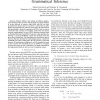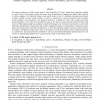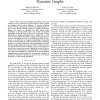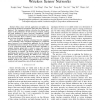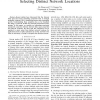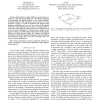INFOCOM
2009
IEEE
15 years 7 months ago
2009
IEEE
Abstract—Modern military and civilian surveillance applications should provide end users with the high level representation of events observed by sensors rather than with the raw...
111
Voted
INFOCOM
2009
IEEE
15 years 7 months ago
2009
IEEE
The erasure resilience of rateless codes, such as Luby-Transform (LT) codes, makes them particularly suitable to a wide variety of loss-prone wireless and sensor network applicati...
101
click to vote
INFOCOM
2009
IEEE
15 years 7 months ago
2009
IEEE
— In this paper, we study sensor enabled landmine networks by formulating a minimum-cost mine selection problem. The problem arises in a target defence scenario, where the object...
102
click to vote
INFOCOM
2009
IEEE
15 years 7 months ago
2009
IEEE
—We propose an embedding and routing scheme for arbitrary network connectivity graphs, based on greedy routing and utilizing virtual node coordinates. In dynamic multihop packet-...
109
click to vote
INFOCOM
2009
IEEE
15 years 7 months ago
2009
IEEE
Abstract—Many sensor network applications are tightly coupled with the geometric environment where the sensor nodes are deployed. The topological skeleton extraction has shown gr...
80
Voted
INFOCOM
2009
IEEE
15 years 7 months ago
2009
IEEE
—Recent studies have discovered that the Internet delay space has many interesting properties such as triangle inequality violations (TIV), clustering structures and constrained ...
INFOCOM
2009
IEEE
15 years 7 months ago
2009
IEEE
—Sensor network localization is an instance of the NP-HARD graph realization problem. Thus, methods used in practice are not guaranteed to find the correct localization, even if...
INFOCOM
2009
IEEE
15 years 7 months ago
2009
IEEE
—The topology of the Internet has been extensively studied in recent years, driving a need for increasingly complex measurement infrastructures. These measurements have produced ...
109
click to vote
INFOCOM
2009
IEEE
15 years 7 months ago
2009
IEEE
—In cognitive wireless networks where secondary users (SUs) opportunistically access spectral white spaces of primary users (PUs), there exists an inherent tradeoff between sensi...
INFOCOM
2009
IEEE
15 years 7 months ago
2009
IEEE
Abstract—Opportunistic routing (OR) has received much attention as a new routing paradigm due to its efficient utilization of broadcasting and spacial diversity of the wireless ...
